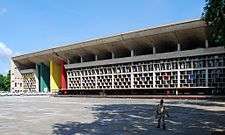Punjab and Haryana High Court
| Punjab and Haryana High Court | |
|---|---|
|
High Court building | |
| Established | 1919, relocated in 1947 |
| Country | India |
| Location | Sector 1, Chandigarh |
| Authorized by | Constitution of India |
| Decisions are appealed to | Supreme Court of India |
| Judge term length | mandatory retirement by age of 62 |
| Number of positions | 85 (64 permanent, 21 additional) |
| Website | http://www.highcourtchd.gov.in/ |
| Chief Justice | |
| Currently | S.J.Vazifdar, Chief Justice |
| Since | 26 July 2014 |
| Lead position ends | 25 February 2015 or till transferred/elevated |
Punjab and Haryana High Court is a High Court-based inside the Le Corbusier-designed Chandigarh Capitol Complex in Chandigarh, India. It has jurisdiction over the Union territory of Chandigarh, the State of Haryana, and the State of Punjab. As of 21 March 2015, there are 55 judges in the High Court, comprising 45 permanent and 10 additional judges. Past judges include Jagdish Singh Khehar, who was elevated to the Supreme Court of India.[1][2][3]
The court building is known as the Palace of Justice. Designed by Le Corbusier, it and several of his other works were inscribed as UNESCO World Heritage Sites in July 2016.[4][5]
History
Punjab and Haryana High Court was formerly known as Lahore High Court, which was established on 21 March 1919. The jurisdiction of that court covered undivided Punjab and Delhi. From 1920 to 1943, the Court was conferred with extraterritorial jurisdiction over that part of China that formed part of the British consular district of Kashgar, which had previously been under the jurisdiction of the British Supreme Court for China.[6] This ceased upon the ratification of the British-Chinese Treaty for the Relinquishment of Extra-Territorial Rights in China.[7]
Following the independence of India on 15 August 1947, a separate High Court of Punjab was created, based at Shimla. This had jurisdiction over Indian Punjab, Delhi and what are now Himachal Pradesh and Haryana. From 17 January 1955, the Court was moved to its present location in Chandigarh.
The creation of Himachal Pradesh on 15 August 1948 led to a separate Court of Judicial Commissioner (similar to a High Court) being established for that state and thus the jurisdiction of the Punjab court was reduced. A separate High Court was constituted for the Union Territory of Delhi under the Delhi High Court Act, 1966.[8] Three Judges of the Punjab High Court were transferred to the Delhi High Court, which was constituted on 31 October 1966.
The States Reorganisation Act, 1956 paved the way for the formation of Haryana and the Union Territory of Chandigarh from 1 November 1966. Those formations also saw the renaming of the High Court of Punjab as the High Court of Punjab and Haryana. The Judges of the High Court of Punjab became Judges of the common High Court with all the powers and jurisdiction of the High Court of Punjab. However, the principal seat of the High Court remained at Chandigarh.
The High Court of Punjab and Haryana has operated since 1 November 1966 in its present form.
See also
References
| Wikimedia Commons has media related to Palace of Justice (Chandigarh). |
| Wikimedia Commons has media related to Chandigarh Capitol Complex. |
- ↑ Tribune News Service. "HC starts e-filing, gets Wi-Fi complex".
- ↑ http://highcourtchd.gov.in/sub_pages/left_menu/publish/announce/announce_pdf/protection_15032013.pdf
- ↑ "Hon'ble Chief Justice and Judges of the High Court of Punjab and Haryana".
- ↑ "The Architectural Work of Le Corbusier". UNESCO World Heritage Centre. United Nations Educational, Scientific and Cultural Organization. Retrieved 19 July 2016.
- ↑ "Chandigarh's Capitol Complex is now a UNESCO heritage site". Retrieved 18 July 2016.
- ↑ The China (Kashgar) Order in Council, 1920, The London Gazette: no. 31821. pp. 3153–3163. 12 March 1920.
- ↑ "Treaty for the Relinquishment of Extra-Territorial Rights in China and the Regulation of Related Matters (Cmd. 6456)" (PDF). Foreign and Commonwealth Office. 11 January 1943., implemented by The China Order in Council, 1943, The London Gazette: no. 36029. pp. 2331–2332. 25 May 1943.
- ↑ The Delhi High Court Act, 1966, Act No. 26 of 1966
Coordinates: 30°45′26″N 76°48′24″E / 30.7573°N 76.8066°E
